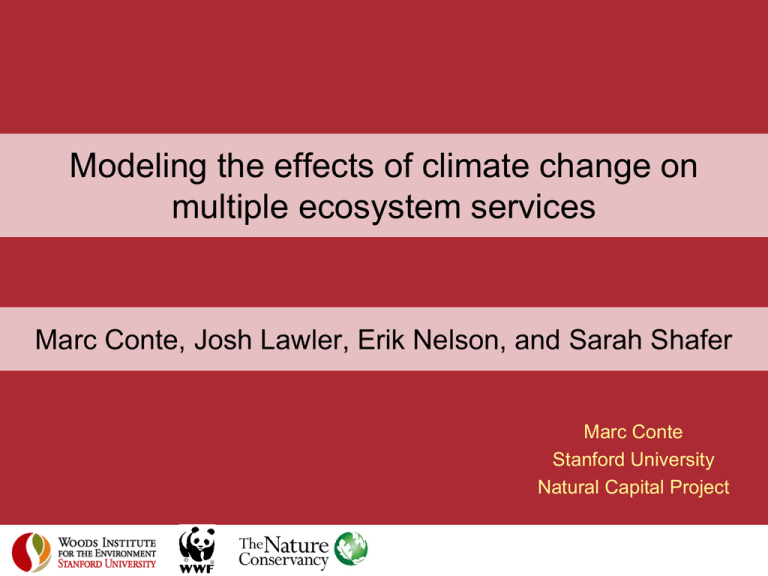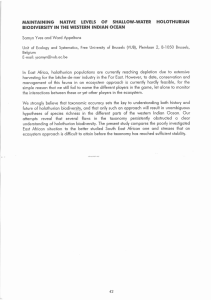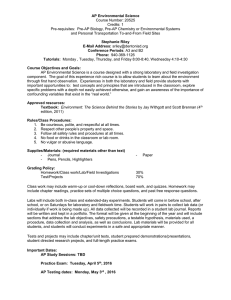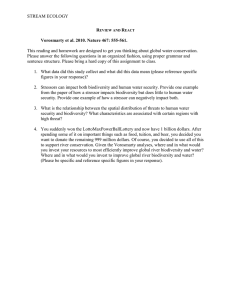Modeling the effects of climate change on multiple ecosystem services Marc Conte
advertisement

Modeling the effects of climate change on multiple ecosystem services Marc Conte, Josh Lawler, Erik Nelson, and Sarah Shafer Marc Conte Stanford University Natural Capital Project Ecosystem services • Ecosystems provide a wide array of goods and services of value to people (ecosystem services) – Provision entails foregone intensive land-use – Tradeoff between social value of provision vs private payoffs • Service supply is determined by biophysical properties, based on land cover • Realized supply is a function of service supply and demand for services from society Welfare impacts of climate change Research questions • How will ecosystem services change as climate regimes shift? • How will land-use decisions that ignore climate change impact the provision and value of different services? • How would landowners alter land-use decisions if the impacts of climate change were considered? Approach -- InVEST • GIS-based tool that uses biophysical and economic models to quantify and value a suite of ecosystem services • InVEST converts user-provided data into spatiallyexplicit outputs of service provision and valuation – Scenario-based model relevant for policymakers – Capacity to address biodiversity and multiple services • Tiered models provide outputs at varying spatial and temporal resolutions given data availability • Product of The Natural Capital Project Approach -- Methodology • We compare provision under different climate regimes on predicted future landscapes in the Willamette Basin – Climates • 2000 (observed) • 2055 (estimated from Hadley GCM) – Landscapes (Hulse et al., 2002) • Planned Trend • Conservation • Development • We consider the impact of altered climate on – Water available for irrigation – Carbon storage and sequestration – Biodiversity Approach -- Climate data • Future climate regime derived from the UKMO-HadCM3 coupled atmosphere-ocean GCM simulation under the A2 emissions scenario – Total monthly precipitation – Mean monthly temperature • The predicted climate variables were downscaled spatially to a 30-second grid covering the Willamette Basin (Lawler et al., in press) Approach -- Irrigation • We focus on five different agricultural products – – – – Blackberries/Raspberries Blueberries Strawberries Wine grapes • CropWat 4.0 (FAO, 1992) predicts crop-specific irrigation demand based on local climate regime Irrigation -- InVEST Change in irrigation demand Approach -- Carbon • Changes in carbon storage and sequestration are driven by changes in vegetative cover due to climate change – We track carbon stored in biomass and soil • Given timber harvest in the area, we consider the extent to which management might moderate predicted veg change – Unmanaged scenarios -- maps show all changes predicted by cover model – Managed scenarios -- maps identify changes that cannot be mitigated by society Carbon -- InVEST Approach -- Biodiversity • Calculate a marginal biodiversity value for each parcel (500 ha hexagon) • MBV~proportion of total biodiversity contained on parcel – Function of number of species with potential range overlapping the parcel – Function of fraction of each species’ compatible habitat area contained by the parcel (breeding or foraging) • Consider change in MBV from 2000 to 2050 climates – In 2000, data on 190 native species – Allow movement into/out of Basin under future climate regime Biodiversity Concluding thoughts • Climate change will impact social welfare through effects on ecosystem-service provision • Land-use plans can be adjusted to mitigate welfare impacts of climate change • Land management may help offset welfare impacts of climate change • http://invest.ecoinformatics.org








